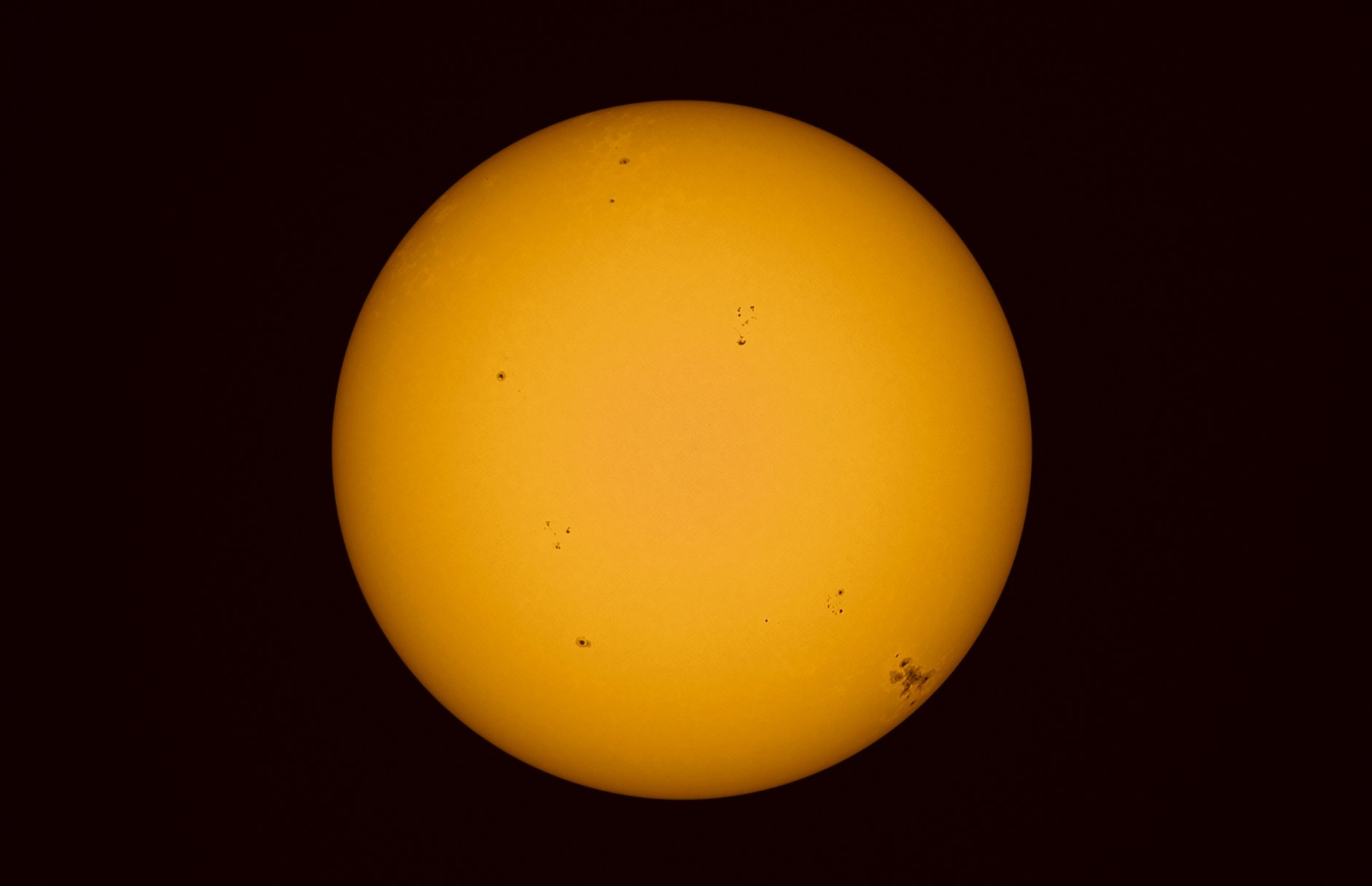An underutilized tool...
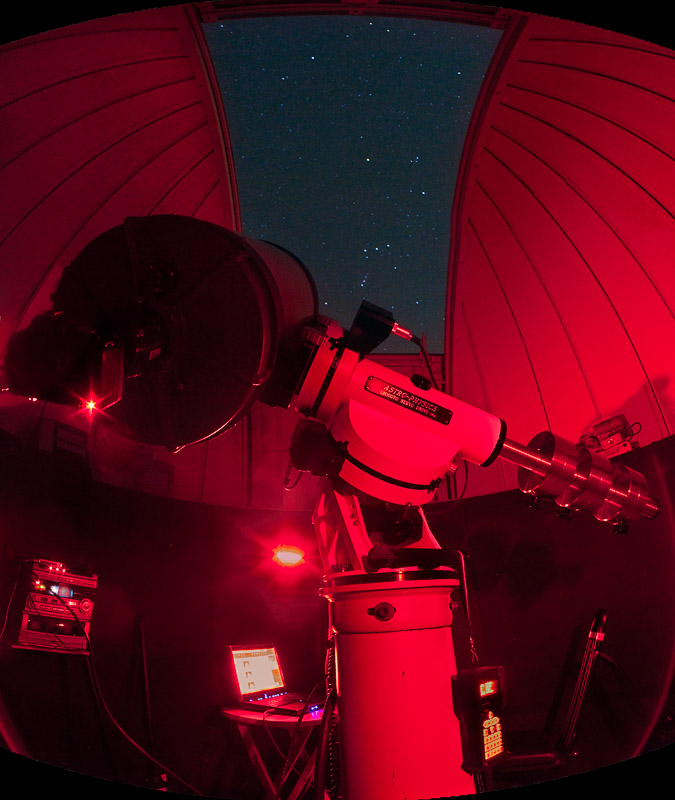 Imaging Orion from the Donald C. Martin ObservatoryOur local astronomy group and high school are very fortunate to have a wonderful astronomical tool at their convenience. Unfortunately, it is severely underutilized and I am also guilty of not putting the tool to use as often as I should. So recently after a public observing night, I committed to imaging M42 from the dome. The observatory houses a 1970's vintage Celestron 14" Schmidt Cassegrain telescope. The scope still performs marvelously and was refurbished a dozen years or so ago. The scope is housed in a similarly aged Ash dome. What has really made the scope perform wonderfully is the relatively new Astro-Physics 1200 GTO mount. The mount was made for the rather bulky C14 and the two perform flawlessly together.
Imaging Orion from the Donald C. Martin ObservatoryOur local astronomy group and high school are very fortunate to have a wonderful astronomical tool at their convenience. Unfortunately, it is severely underutilized and I am also guilty of not putting the tool to use as often as I should. So recently after a public observing night, I committed to imaging M42 from the dome. The observatory houses a 1970's vintage Celestron 14" Schmidt Cassegrain telescope. The scope still performs marvelously and was refurbished a dozen years or so ago. The scope is housed in a similarly aged Ash dome. What has really made the scope perform wonderfully is the relatively new Astro-Physics 1200 GTO mount. The mount was made for the rather bulky C14 and the two perform flawlessly together.
The dome is located just south of the main city limits of Huntington, WV and is victim to a fair amount of light pollution. But recent developments in DSLR technology and filtration have made imaging some objects from the dome a workable situation.
My recent experimentation with the new crop of DSLR's show amazing signal gathering without a compromise in noise at ISO's as high as 6400. 6400 ISO is nuts...right? The DSLR manufacturers have really come a long way in their software/hardware combinations to improve signal while reducing noise. Combining this type of camera sensitivity with a light pollution filter permits imaging of certain objects in the hydrogen alpha range of light. I won't go into detail about all of the technicals around this, but basically most astronomical objects glow at the magical hydrogen alpha line of light and fortunately most of our light pollution does not cross that wavelength and can be filtered out.
So I will post separately my first image from the D.C. Martin Observatory and I look forward to working more frequently with such amazing equipment. I believe I can fulfill many artistic objectives with this gear in the future.
ATIK Camera's Warren Keller discusses CCD offerings
http://www.youtube.com/watch?v=E1WwhUTMD1EWarren Keller of ATIK camera from Jeff Ball on Vimeo.
U.S. representative Warren Keller discusses ATIK CCD cameras now available in the U.S.
You can find ATIK USA at the link below
http://www.atik-usa.com/
A very special THANKS to Tom Kennedy for technical assistance on video production.
Al Nagler discusses his astrophotography endeavors
Al Nagler discusses his astrophotography endeavors from Jeff Ball on Vimeo.
Noted telescope designer Al Nagler discusses his early efforts at astrophotography and current telescope designs aimed at improving imaging performance of his telescopes. A wonderful few minutes spent with one of the industry's icons and a terrific ambassador for the amateur astronomy community. I am sure you will enjoy the discussion and learn a thing or two.
This video is part of a project I am putting together, but felt that Mr. Nagler's presentation stood on its own from an entertainment and information point of view.
I have had an opportunity to image with Televue instruments over the years including the TV85 and TV101. These instruments are capable of taking wonderful astrophotos. The TV101 and TV127 IS systems are particularly noted for their astrophotographic performance. I encourage you to consider Televue for your astrophotography needs, not to mention those unbelievable eyepieces for the visual astronomer!
A very special THANK YOU to Tom Kennedy for his technical assistance on video production!!
Thanks and clear skies.
Delicate surgery required...
General use photography has a different wave-length preference than astrophotography. The all-important hydrogen alpha line for most emission nebula is right around the 656nm part of the spectrum. (For some examples of emission nebula like the Horsehead Nebula and Orion Nebula, please see my portfolio on this website.) This line has been blocked by special filters in nearly every DSLR camera made today. I have read that this part of the spectrum was not preferred when it comes to portrait work and attaining accurate skin tones. That may or may not be true, but most manufacturers place filters in front of the sensor that block some or all of the hydrogen alpha wavelength.
Astrophotography can certainly be performed with any DSLR camera. Jerry Lodriguss has a wonderful article on the wavelengths important to astrophotography and the differences between a modified and un-modified camera and how to optimize imaging with each. For the most efficient use of a DSLR in astrophotography, one must modify the camera. This requires surgery by a skilled surgeon!
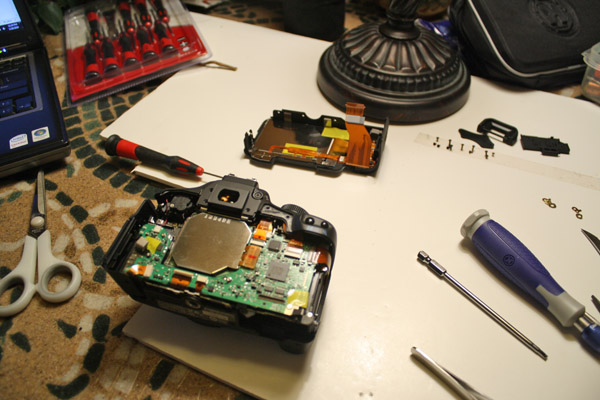
I am very fortunate to know just such a person. Brent Maynard, a friend and member or our local astronomy club the Ohio Valley Astronomical Society, is my local "DSLR Surgeon." Above you can see part of the process where he begins to modify a Canon T1i or 500D.
The most important part of the modification is removing one of the two filters that are placed in front of the imaging sensor. The filter to be removed only permits about 23% of the available hydrogen alpha light through to the imaging sensor. Remember that the emission nebulae we seek to image are emitting light at that part of the spectrum of light at 656nm. So it is vitally important to remove that filter to allow maximum gathering of those photons for the best images possible.
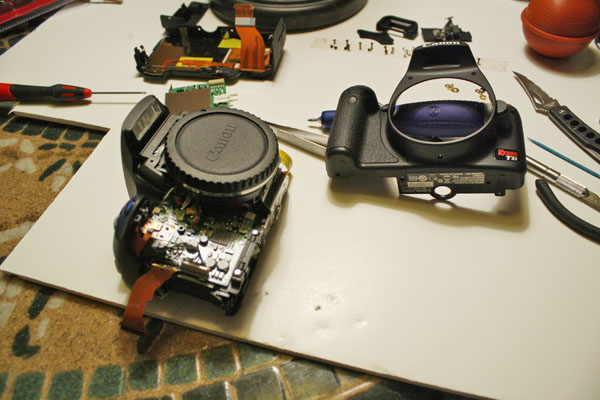
Brent is very skilled in electronics and has studied numerous hours on how to go about performing this delicate operation. It is certainly not an activity to simply jump into without a significant amount of study. I believe this camera will be Brent's fifth or sixth modification. He recently modified a 450D for me and it has been my primary imaging camera to date.
The entire goal of this procedure is to improve the amount of signal (the photons being emitted by the nebulae at the 656nm part of the spectrum) while reducing the amount of noise (light pollution, camera noise) and thus improve as much as possible the ratio of signal to noise.
One of the most appealing aspects of the 500D or T1i is the very high ISO capabilities while delivering low electronic noise. I hope to utilize the camera's high ISO of at least 3200 while employing a Hutech Light Pollution filter. My hope is that this combination will give me excellent signal (656nm spectrum allowed to pass to the sensor while light and air pollution are being filtered by the Light Pollution Filter) while reducing exposure times and eliminating the need to autoguide the astrophotography mount-that's an entirely different discussion.
So for now, I have two modified astroimaging DSLR cameras to take to the Winter Star Party next week. All thanks to my wonderful DSLR surgeon, Brent Maynard. Thanks Brent and hoping for some wonderful imaging condition in southern Florida next week.
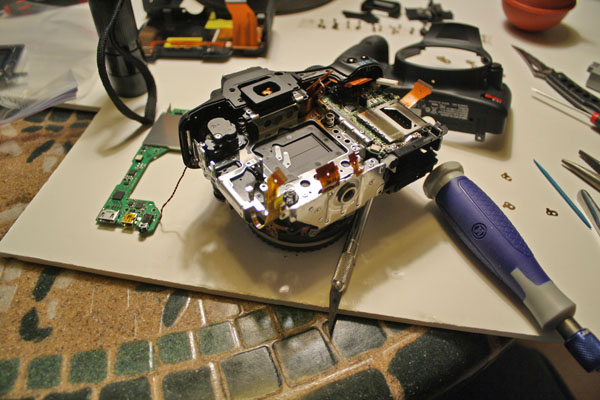
Less is more...
In digital astrophotography, the key is to capture more signal to overcome the noise. You know noise when you see it and I am not going into a deep technical explanation of how it originates and what it is, but I know it when I see it.
I started astrophotography with the 350D and saw noise, especially color noise, that I knew had to be dealt with by traditional noise reduction methods. Those methods involve subtracting dark frames from the light frames.
Later I began using the Canon 450D and noticed a huge difference in noise. There was hardly any to speak of, even after moderate stretching of the data. This led me to experiment with a new way of optimizing the data without utilizing dark frame subtraction. That new technique is detailed in the archived webinar under the "digital photography education" tab.
Now comes the 500D and thankfully dedicated astronomers like Gary Honis put together bench testing of cameras so we know how they will perform. The 500D has even lower noise than the 450D and offers those ultra-high levels of ISO up to 6400. Now this will be exciting and is why I am ordering one soon.
Here is a link to Gary's test. This is a new day in DSLR photography, one that I hope will see the end to autoguiding as well as dark frame subtraction. Enjoy the new day!
Jeff's Blog
Join me on photography journeys from desert landscapes to deep sky wonders.








